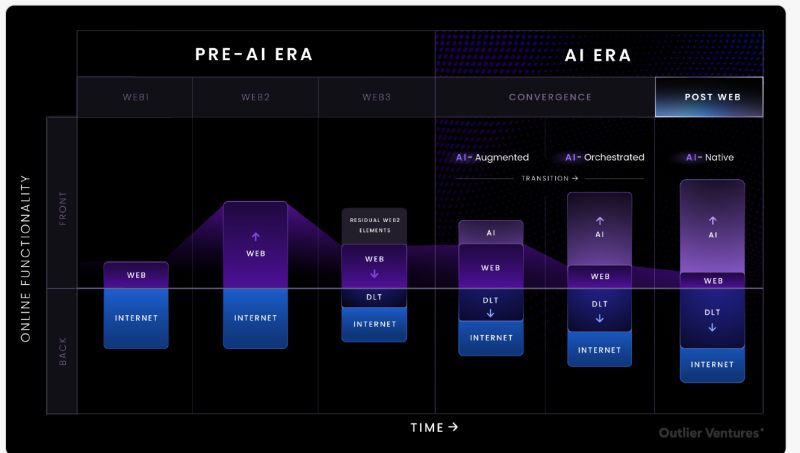The digital landscape is evolving rapidly, and the concept of the Agentic Web—a decentralized ecosystem where autonomous agents act, collaborate, and make decisions on behalf of users—is emerging as a transformative vision. In their foundational paper , the authors of the Agent Network Protocol (ANP) outline how the Agentic Web differs from traditional systems by prioritizing decentralization, interoperability, and autonomy. But as we reimagine a web powered by intelligent agents, one critical question arises: How do these agents securely and independently manage their identities in a trustless environment? The answer lies in Web3 self-sovereign identity (SSI) —a framework that is not just beneficial but necessary for the Agentic Web to reach its full potential.
The Agentic Web: A Quick Recap
Their paper highlights three pillars of the Agentic Web:
1. Decentralization: Agents operate without reliance on centralized platforms.
2. Interoperability: Agents seamlessly interact across diverse protocols and ecosystems.
3. Autonomy: Agents act independently, making context-aware decisions on behalf of users.
These principles challenge the status quo of siloed platforms and centralized control. However, achieving this vision requires solving a fundamental problem: How do agents prove who they are, whom they represent, and what they’re authorized to do in a decentralized world?
Why Self-Sovereign Identity (SSI) is Non-Negotiable
Traditional identity systems—think usernames, OAuth logins, or certificate authorities—are ill-suited for the Agentic Web. They depend on centralized intermediaries, create single points of failure, and lack user control. Here’s why Web3 SSI fills this gap:
1. Autonomy Demands Independent Identity
Agents must act autonomously, which means they need self-owned identities to authenticate actions, sign transactions, or negotiate permissions without human intervention. SSI, built on decentralized identifiers (DIDs) and verifiable credentials, allows agents to:
– Create and manage their own identities on-chain or peer-to-peer.
– Prove authenticity (e.g., “This agent is authorized by User X to book flights”).
– Maintain continuity across interactions, even as they traverse multiple networks.
Without SSI, agents would rely on fragmented, platform-specific logins—undermining the autonomy that defines the Agentic Web.
2. Trust in a Trustless Environment
In a decentralized ecosystem, agents must be able to verify each other. SSI enables cryptographic proof of identity, ensuring that:
– A medical AI agent interacting with a patient’s health data is genuinely authorized.
– A supply-chain agent can validate the credentials of a logistics partner.
This eliminates impersonation risks and reduces reliance on vulnerable central authorities.
3. Interoperability Through Universal Standards
The Agentic Web’s interoperability hinges on agents understanding and trusting each other across protocols. SSI provides a universal language for identity:
– DIDs and verifiable credentials (VCs) are W3C standards, ensuring compatibility.
– An agent built on ANP can seamlessly interact with agents on other networks (e.g., Polkadot, IPFS) if they share SSI frameworks.
Without this, the Agentic Web risks becoming a collection of isolated agent “silos.”
4. User Sovereignty and Compliance
SSI ensures that agents act as extensions of user-controlled identities. For example:
– A user delegates tasks to an agent via a VC, specifying time-bound permissions.
– User privacy compliance is simplified because users—not corporations—hold and revoke access.
This aligns with the Agentic Web’s ethos of shifting power from platforms to individuals.
The Risks of Ignoring SSI
Imagine an Agentic Web without self-sovereign identity:
– A delivery agent could be spoofed, sending fake tracking updates.
– Financial agents might rely on insecure API keys tied to centralized exchanges.
– Users lose control over how their agents’ data is shared.
Centralized identity models reintroduce the very vulnerabilities the Agentic Web aims to solve.
Building the Future: SSI + Agentic Web
Projects like the Agent Network Protocol, Model Context Protocol and Unified Intent Mediator Protocol are pioneering the infrastructure for autonomous agents. Integrating SSI into this framework is the logical next step. Here’s how it could work:
– DIDs for Agents: Each agent generates a DID, anchoring its identity on a blockchain or decentralized network.
– Verifiable Credentials for Permissions: Users issue VCs to agents, specifying scope (e.g., “Access my calendar until December 2024”).
– Zero-Knowledge Proofs (ZKPs): Agents prove compliance with rules (e.g., age verification) without revealing unnecessary data.
Identity as the Foundation
The Agentic Web promises a future where agents handle everything from mundane tasks to complex negotiations. But without self-sovereign identity, this vision lacks the security, interoperability, and user control required to thrive. Web3 SSI isn’t just a complementary technology—it’s the bedrock upon which autonomous agents can securely and independently operate. As projects like ANP, MCP and UIM advance, prioritizing SSI integration will ensure the Agentic Web remains truly decentralized, user-centric, and resilient.
The future is agentic. Let’s make sure it’s self-sovereign too.

